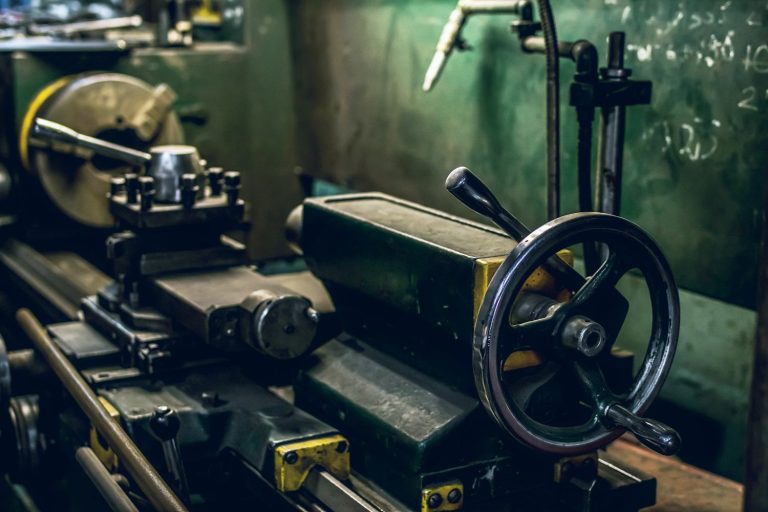Best Corded Jigsaw for Uninterrupted Cutting Power
Finding the right power tool is essential for any DIYer or professional contractor.
When it comes to cutting through wood and other materials, a corded jigsaw is an excellent choice.
With uninterrupted power running into the motor, corded jigsaws help ensure you get your job done quickly and safely – plus they generally come with more features than their battery-powered cousins!
In this article, we’ll look at the different types of corded jigsaws available on the market and what features you should be looking out for when making your purchase decision.
Read on to learn all about selecting the best corded jigsaw for your needs!
How We Choose the Best Corded Jigsaws
With so many jigsaw brands and models to choose from, how do you know which one is the best for your needs?
It can be tough to figure out what separates the good jigsaws from the great ones. And with such a wide range of prices, it’s hard to know if you’re getting a good deal.
We did all of the hard work for you. After reading through thousands of Amazon reviews and taking a deep dive into the specs of each jigsaw, we’ve chosen the best corded jigsaws for a variety of projects. Whether you’re a DIY enthusiast or a professional contractor, we have the perfect saw for you.
Overall Winner – Best Corded Jigsaw
BOSCH JS260 120-Volt Top-Handle Jigsaw
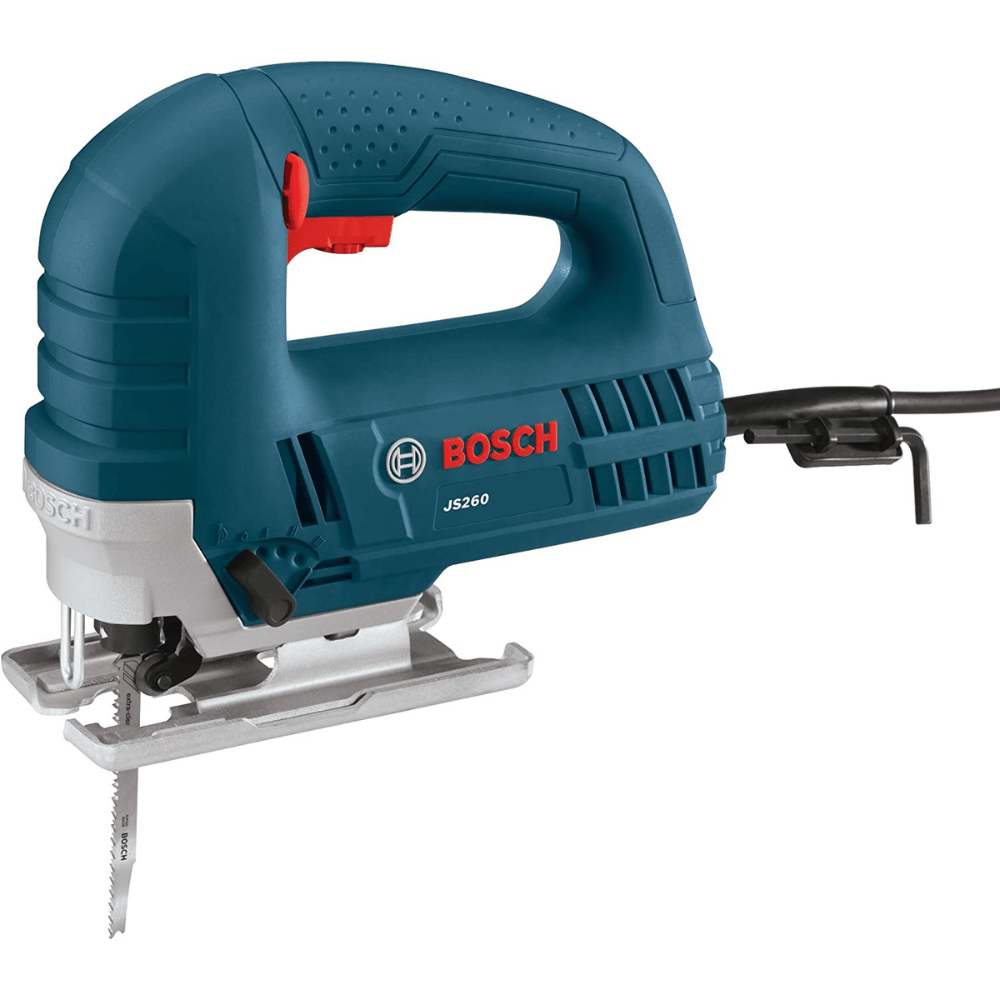
Key Features
- 6 amp motor delivering up to 3,100 strokes per minute
- Dust blower
- 3/4-inch stroke length
Why It’s a Great Choice
Take your projects to the next level with this Bosch Jigsaw.
This top-of-the-line jigsaw is engineered with precision and accuracy in mind and provides DIYers, contractors, and advanced craftspeople alike with a powerful tool that can easily take on even the toughest cuts.
The variable speed dial controls the maximum cutting speed and the accelerator trigger regulates the operating speed for optimal performance.
It also features a low-vibration plunging design for cutting accuracy, a large heavy-gauge steel footplate for stability, a multidirectional tool-less blade clamp providing superior grip of T-shank blades, and a convenient toolless blade change system for quick insertion and removal.
An always-on dust blower for max cut visibility, an ergonomic top handle for comfortable gripping, and a two-finger trigger help make this tool ideal for tackling even the most challenging projects with ease.
Trust Bosch’s commitment to quality to help you get the job done with consistent results each time – invest in this reliable power tool today!
Best Budget Corded Jigsaw
BLACK+DECKER BDEJS600C Jigsaw
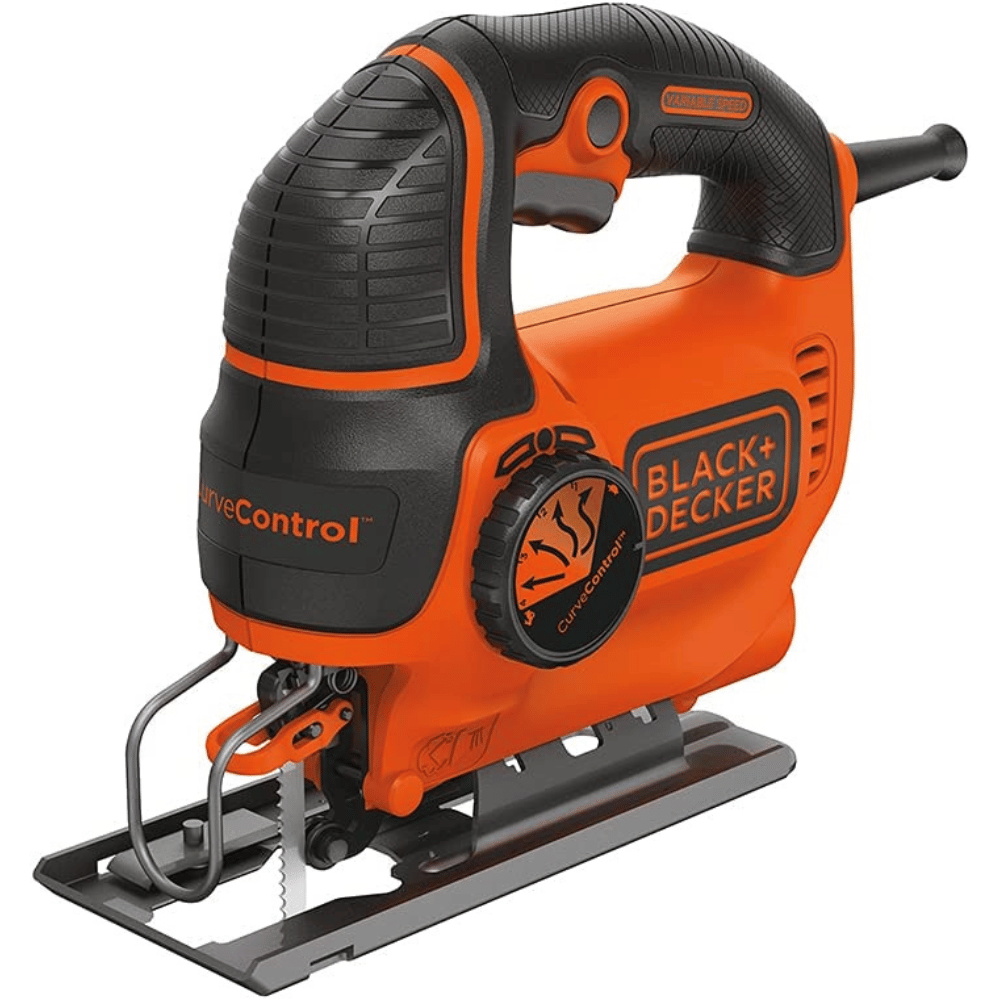
Key Features
- 5 amp motor generating up to 3,000 SPM
- 3/4″ blade orbital action
- CurveControl Technology
Why It’s a Great Choice
For a precise, powerful sawing experience, the BLACK+DECKER BDEJS600C Jigsaw is a perfect choice.
Featuring custom CurveControl technology with four different orbital settings to maximize control on intricate curves, it is ideal for any DIYer or contractor.
With a variable-speed motor delivering up to 3,000 strokes per minute, this jigsaw can slice easily through wood, metal, and plastic with accuracy and precision.
Ensure a clear line of sight and accurate results courtesy of the integrated wire guard along with effortless blade switching thanks to the tool-free blade change feature.
Beveled cuts up to 45 degrees? No problem – just adjust the shoe bevel accordingly.
Professional results are guaranteed every time with this Black+Decker jigsaw!
Best Speed Control Jigsaw
PORTER-CABLE PCE345 Orbital Jig Saw
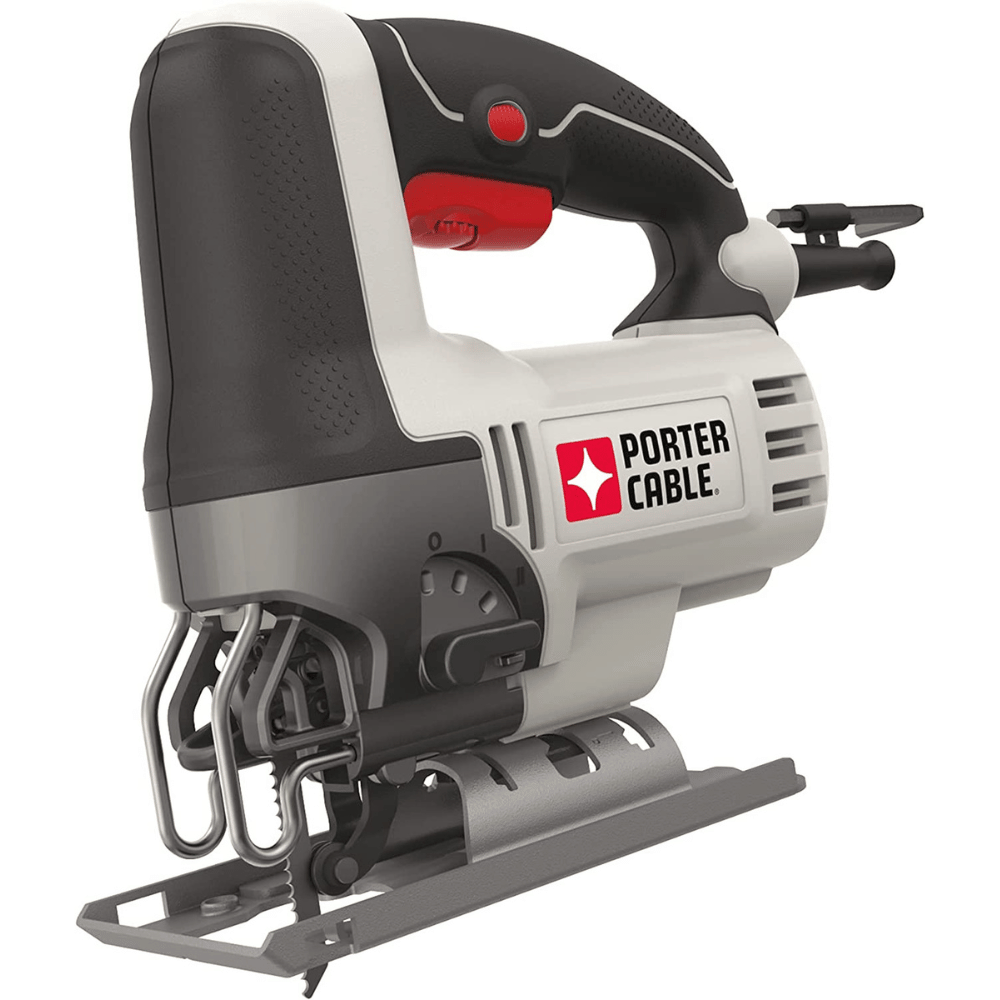
Key Features
- 6 amp motor powering up to 3,200 SPM
- 7-position speed dial integrated into the trigger
- 4 orbital settings for different materials
Why It’s a Great Choice
The PORTER-CABLE PCE345 Orbital Jig Saw is the ultimate choice for any DIYer or contractor looking for maximum power and precision.
This powerful 6 Amp jig saw features a 7-Position Speed Dial integrated into its trigger, giving you multiple speed settings and optimal cutting results.
Additionally, its 4 orbital settings ensure it’s always operating at peak performance in any material.
What’s more, its Lock-On Button allows for easier control during prolonged use – perfect for those long days in the workshop.
The PORTER-CABLE PCE345 is a tool packed with intuitive features designed to make your projects run smoothly and efficiently, whether you’re crafting furniture or building a deck.
Don’t take chances: get the power of PORTER-CABLE today, and see just how easy it is to get professional results for any job.
Best Low Vibration Corded Jigsaw
DEWALT DW331K Jigsaw
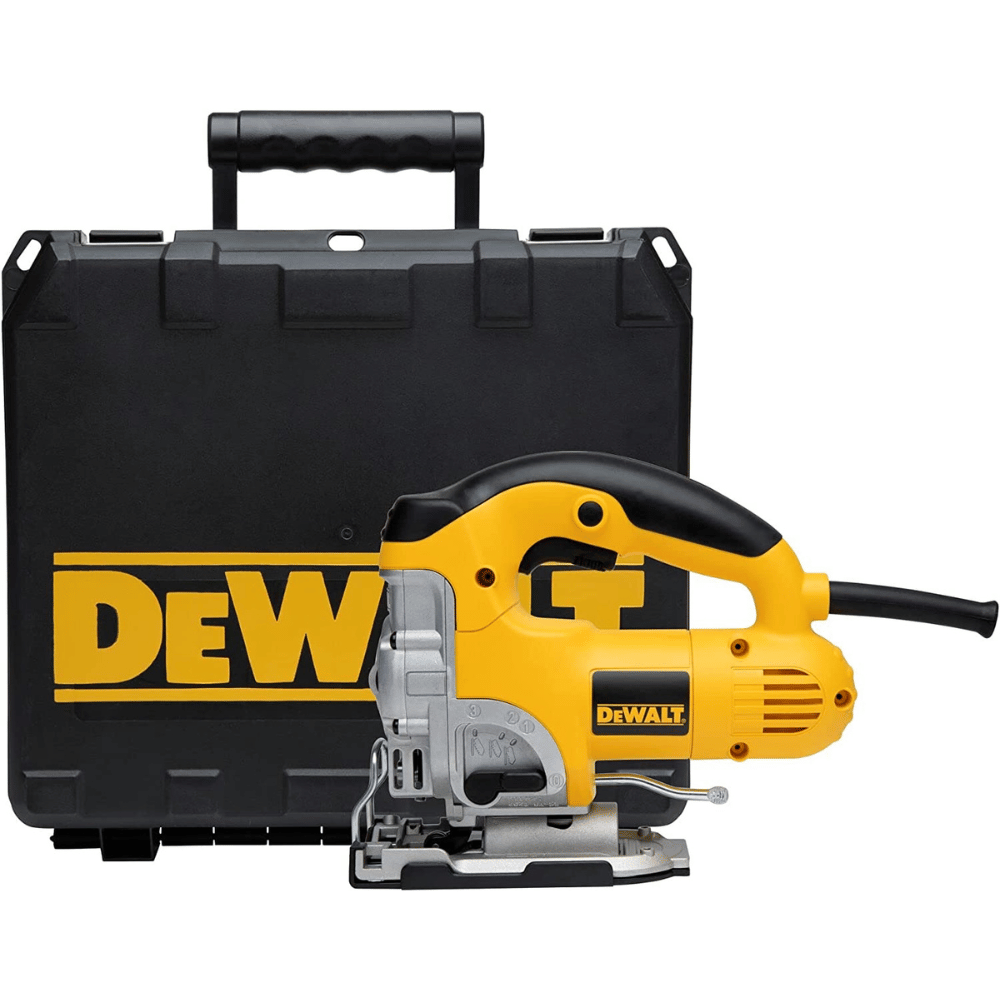
Key Features
- 6.5 amp motor delivering 500-3,100 SPM
- Integrated dust blower and LED light
- Non-marring plastic shoe cover
Why It’s a Great Choice
Transform your projects with this DEWALT jigsaw.
Experienced DIYers and contractors know that this tool is a must-have for cutting curves, complex shapes, and fine details.
Whether you need to make an intricate relief in wood or an oddly shaped hole in metal, this jigsaw does the job efficiently and evenly.
The 6.5 amp motor provides dependable power for exceptional performance in any material.
Plus, it comes equipped with variable-speed control for application-specific specialized uses — so you can tailor the speed to fit your project’s needs.
And a counterbalance mechanism keeps vibrations to a minimum during extended use, providing superior balance and control even in demanding applications.
Tool-less blade changes are a breeze with the keyless blade lever allowing you to pop blades in and out with one hand.
The DEWALT DW331K Jigsaw makes it easy to switch between cuts or intersects with convenient bevel detents at 0, 15, 30 and 45 degrees.
Not only that, but its non-marring plastic shoe cover protects work surfaces ensuring no scratches or blemishes occur while you’re building your masterpiece!
Don’t trust cheap power tools – invest in quality with the DEWALT DW331K Jigsaw!
Best Barrel Grip Jigsaw
BOSCH JS470EB Corded Barrel-Grip Jigsaw
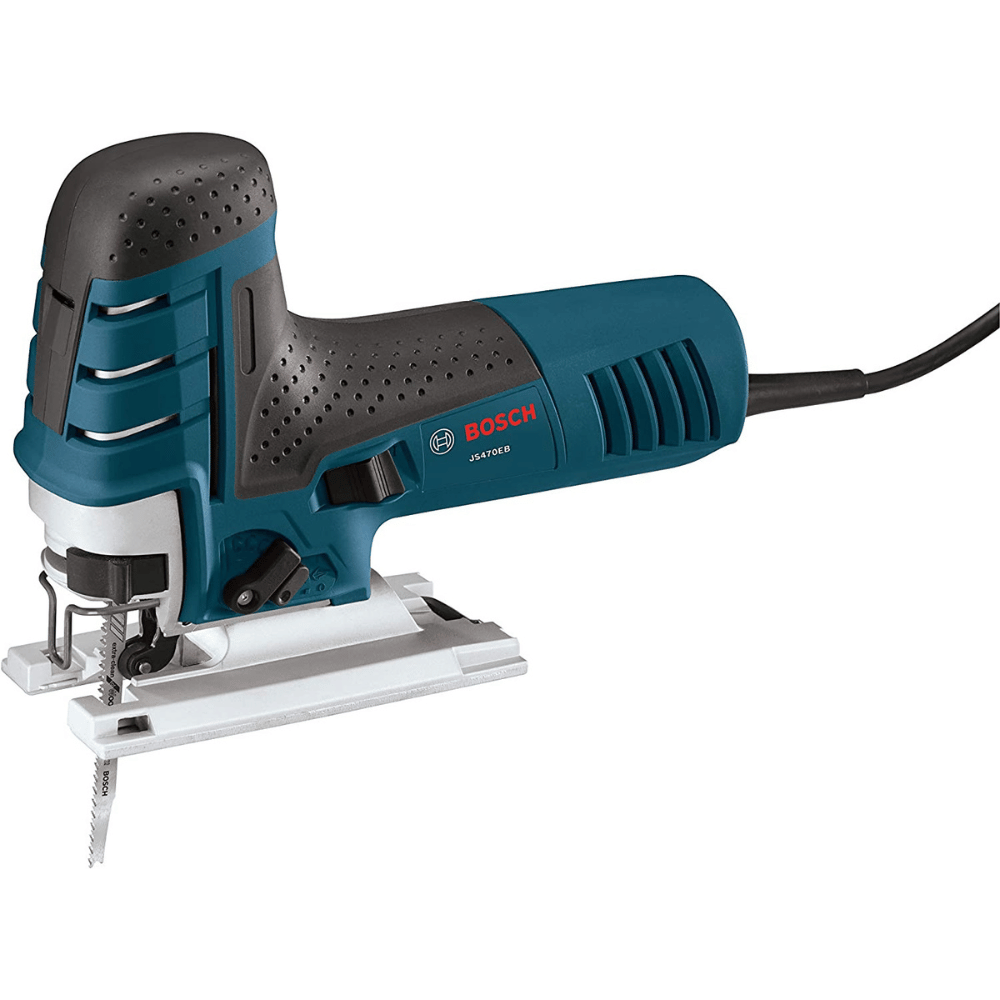
Key Features
- 7 amp motor with up to 3,100 SPM
- Constant Response circuitry
- 1-inch stroke length
Why It’s a Great Choice
The BOSCH JS470EB Corded Barrel-Grip Jigsaw is a powerful and versatile tool that offers precise cutting with total control.
It features Bosch’s Constant Response circuitry, giving users a soft-start launch, smooth operation, consistent velocity under load, and overload protection.
With its variable speed dial, users can easily adjust the jig saw’s operating speed to choose the most appropriate action for their job.
The heavy-duty aluminum gearbox has an insulated cover for extra safety and durability.
The large die-cast aluminum footplate includes a steel insert for making precise bevel cuts to 45° angles.
This tool also features orbital action settings providing various blade strokes for efficient tackling of tough cutting tasks.
DIYers and contractors alike will appreciate this indispensable tool delivering reliable results with great accuracy without fail.
You can trust that the BOSCH JS470EB Corded Barrel-Grip Jigsaw will help you get your job done right!
Buyer’s Guide to the Best Corded Jigsaw
Corded jigsaws are a great choice for heavy-duty projects, but with so many options on the market, it can be hard to figure out which one is right for you.
Not all corded jigsaws are created equal. With such a wide range of features, it can be tough to know which one is best for your needs.
We’ve compiled some of the most frequently asked questions when shopping for a corded jigsaw to help make your decision easier. Our FAQs include questions about power, blade size, and more.
What are the benefits of using a corded jigsaw over a cordless jigsaw?
As with most power tools, corded jigsaws offer several benefits over their cordless counterparts. Firstly, they tend to be more powerful, making them better suited to cutting through thicker or tougher materials. This is because they are designed to be plugged into an electrical outlet, which means they can draw on a constant and reliable source of power.
Another advantage of using a corded jigsaw is that you don’t have to worry about running out of battery power in the middle of a project. Cordless jigsaws, while convenient in some ways, can be frustrating when they run out of juice mid-cut and need to be recharged or replaced.
Corded jigsaws also tend to be more cost-effective in the long run. While they may require an initial investment, they don’t require replacement batteries or chargers like cordless models do. This means that you’ll save money over time by not having to replace these components.
Finally, corded models often come with variable speed control features that allow for greater precision and flexibility in cutting tasks. This means that you can adjust the speed of the blade according to the thickness and type of material you’re working with, which can help prevent damage or accidents.
Overall, while cordless jigsaws have their advantages in terms of portability and convenience, serious woodworkers and DIY enthusiasts are likely to find that a good quality corded jigsaw offers greater power, reliability, and versatility for their projects.
How do I choose the right blade for my corded jigsaw?
Choosing the right blade for your corded jigsaw is a crucial step in achieving clean, accurate cuts. There are several factors to consider when selecting a blade, including the material you’ll be cutting, the thickness of the material, and the type of cut you want to achieve.
Firstly, consider the material you’ll be cutting. Different blades are designed to cut through different materials such as wood, metal, or plastic. It’s important to choose a blade that is specifically designed for the type of material you’ll be working with to achieve clean and efficient cuts.
Next, think about the thickness of the material you’ll be cutting. Blades come in varying lengths and tooth configurations that are suited for different thicknesses of materials. A general rule of thumb is to choose a blade with at least three teeth engaged in the material at any given time. This helps prevent overheating and prolongs blade life.
Finally, consider what type of cut you’re looking to achieve. For example, if you want a smooth finish on your cut edges then it’s best to use a fine-toothed blade. On the other hand, if speed is more important than smoothness then choose a coarse-toothed blade.
It’s worth noting that there are also specialty blades available for certain applications such as scroll cutting or plunge cutting. These blades can provide specific benefits but may not be necessary for all projects.
In summary, choosing the right blade for your corded jigsaw requires careful consideration of several factors including material type and thickness as well as a desired outcome. By taking these factors into account when selecting your blade, you can ensure that your jigsaw performs optimally and produces high-quality results every time.
What is the difference between T-shank blades and U-shank blades?
When it comes to jigsaw blades, there are two primary types of shank designs: T-shank and U-shank. The main difference between the two is their shape and how they attach to the jigsaw.
T-shank blades have a T-shaped shank that fits securely into the blade clamp on the jigsaw. This design provides a more stable and secure connection between the blade and the tool, resulting in less vibration and improved accuracy during cutting. Additionally, T-shank blades can be quickly and easily swapped out without the need for any additional tools.
U-shank blades, on the other hand, have a U-shaped shank that requires a set screw to secure them into place on the jigsaw. While this design may be less convenient than T-shanks when it comes to swapping out blades, U-shanks do offer some benefits. For example, they tend to be stronger and more durable than T-shanks due to their thicker construction.
It’s worth noting that not all jigsaws are compatible with both types of shanks. Some models are designed specifically for either T-shank or U-shank blades, so it’s important to check your tool’s manual before purchasing new blades.
In general, if you’re looking for convenience and ease of use when swapping out blades then T-shanks may be your best bet. However, if you prioritize durability and strength over convenience then U-shanks may be more suitable for your needs. Ultimately, it’s up to personal preference and what works best for your specific cutting tasks.
Can a corded jigsaw cut through metal or other tough materials?
Yes, a corded jigsaw can cut through metal and other tough materials with the right blade and technique. However, it’s important to note that not all jigsaws are created equal when it comes to cutting through tougher materials.
When cutting through metal or other tough materials, it’s important to use a blade that is designed specifically for that purpose. Blades with carbide or bi-metal teeth are typically the best choice for these types of materials as they are more durable and can withstand the heat generated by cutting through metal.
In addition to using the right blade, it’s also important to have the proper technique when cutting through tough materials. This includes using a slower speed setting on your jigsaw and applying steady pressure throughout the cut. It may also be helpful to use lubricants such as oil or water during the cutting process to reduce heat buildup and prevent damage to both the blade and material.
It’s worth noting that some jigsaws may not be powerful enough to cut through thicker metals or other extremely tough materials. In these cases, it may be necessary to use a different type of tool such as a reciprocating saw or angle grinder.
In summary, a corded jigsaw can certainly cut through metal and other tough materials with the right blade and technique. However, it’s important to choose a blade specifically designed for this purpose, practice proper technique during cutting, and be aware of your tool’s limitations when working with extremely thick or hard materials.
Can I use a corded jigsaw on curved cuts as well as straight ones?
Yes, a corded jigsaw can be used for both curved and straight cuts. One of the key benefits of using a jigsaw is its versatility when it comes to cutting various shapes and curves.
When making curved cuts with a jigsaw, it’s important to use the appropriate blade for the material you’re cutting as well as the desired curve radius. Blades with smaller teeth are typically better suited for tighter curves, while blades with larger teeth are better suited for longer, sweeping curves.
In addition to blade selection, it’s also important to maintain a steady hand and move the tool at an even pace to maintain a smooth curve. It may also be helpful to make relief cuts at tight corners or angles to prevent binding or snagging during cutting.
When making straight cuts with a jigsaw, it’s important to use a guide or fence to ensure accuracy and precision. This can be done using a straight edge or specialized jig that attaches directly to your tool.
In summary, a corded jigsaw can certainly be used for both curved and straight cuts. By selecting the appropriate blade and technique for your specific cutting task, you can achieve accurate and precise results whether you’re working on tight curves or straight lines.
Is it difficult to change jigsaw blades, and how often should I do it?
Changing jigsaw blades is generally a simple process and can be done in just a few steps. Most jigsaws have a blade release mechanism that allows you to quickly and easily swap out blades as needed.
To change a jigsaw blade, first, unplug the tool for safety. Next, locate the blade release mechanism on your tool – this may be a lever or button depending on the model of your jigsaw. Press or pull this mechanism to release the current blade from its holder. Then, insert a new blade into the holder and lock it in place using the same mechanism.
The frequency with which you should change your jigsaw blade depends on several factors such as how often you use your tool, what types of materials you are cutting, and how dull or damaged your current blade is. As a general rule of thumb, you should change your blade when it becomes dull, damaged, or starts to produce rough cuts.
If you’re working with tougher materials such as metal or masonry, you may need to change your blade more frequently than if you’re working with softer materials like wood or plastic. Additionally, if you’re using your jigsaw frequently for long periods, it’s a good idea to check the condition of your blade regularly and replace it as needed to maintain optimal cutting performance.
In summary, changing a jigsaw blade is typically an easy process that can be done quickly and safely using the appropriate tools and techniques. The frequency with which you should change your blade depends on several factors specific to your usage patterns and cutting tasks. By staying aware of these factors and monitoring the condition of your blades regularly, you can ensure optimal cutting performance from your jigsaw over time.
How much power do I need in a corded jigsaw for various types of projects?
The amount of power you need in a corded jigsaw for various types of projects depends on the specific materials and thicknesses you will be cutting, as well as the level of precision and speed required.
For basic DIY or woodworking projects using softwoods or thin materials such as plywood, a lower-powered jigsaw with around 5-6 amps should suffice. These jigsaws are typically less expensive and lighter in weight, making them easier to handle for small projects.
However, if you plan to work with harder woods, metals, or thicker materials such as hardwoods, a more powerful jigsaw with at least 6-7 amps is recommended. This additional power will help prevent bogging down or stalling during cutting and provide smoother, cleaner cuts.
For professional-grade projects that require high precision and speed such as metalworking or industrial applications, even higher-powered jigsaws may be necessary. These models can range from 7-10 amps or more depending on the specific requirements of your project.
It’s important to note that while higher-powered jigsaws can offer increased performance and efficiency for certain tasks, they may also be heavier and more difficult to control than their lower-powered counterparts. Therefore, it’s important to consider both power needs and ease of use when selecting a corded jigsaw for your specific needs.
In summary, the amount of power you need in a corded jigsaw depends on the type of materials and thicknesses you’ll be cutting as well as the level of precision and speed required. By considering these factors carefully when selecting your tool, you can ensure optimal performance for your specific project needs.
How important is a variable speed trigger in a corded jigsaw, and what are its benefits?
Variable speed selection is an essential feature for a corded jigsaw, providing users with greater control and versatility when cutting a variety of materials.
The benefits of having varying speeds include:
- Precision: A variable speed trigger allows you to adjust the speed of the blade to match the specific material and thickness you are cutting. This precision can help prevent damage to your workpiece and ensure cleaner cuts.
- Versatility: Different materials require different speeds to achieve optimal results. With a variable speed trigger, you can easily adjust the speed of your jigsaw to accommodate a range of materials including wood, metal, plastic, and more.
- Safety: By allowing you to start at a slower speed before ramping up to full power, a variable speed trigger helps prevent kickback and reduces the risk of accidents or injury when using your jigsaw.
- Efficiency: When working with delicate or intricate cuts, it’s important to have precise control over your tool’s speed. A variable speed trigger allows you to slow down or speed up as needed without having to stop and change settings manually.
Overall, variable speed control is an incredibly important feature for any corded jigsaw user. Whether you’re working on DIY projects at home or tackling professional-grade jobs in an industrial setting, having precise control over your tool’s speed can make all the difference in achieving optimal results while minimizing risks and ensuring safety.
Choosing the Best Corded Jigsaw
To wrap it up, the perfect corded jigsaw for your tool collection is out there.
If you want the highest quality, it’s important to do some research and consider what you want it to do.
We’ve done the legwork for you by narrowing down our top 5 corded jigsaws based on efficiency, quality, affordability, and user ratings.
Each of these five products offers something a little different for different needs but are all great options for anyone in search of the best jigsaws in town.
Whether you need one for a professional project or your DIY home renovations, we hope this guide helps you find what you’re looking for in your next cordless jigsaw purchase.
So go ahead, check out the prices on Amazon, and get yours now!




